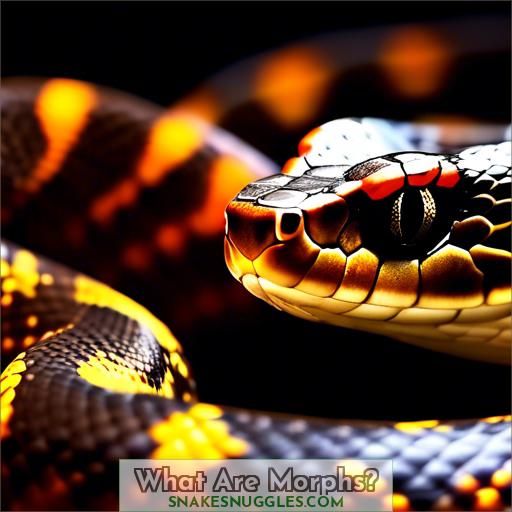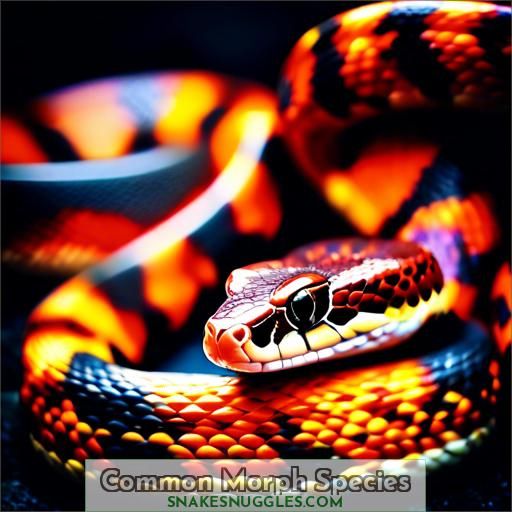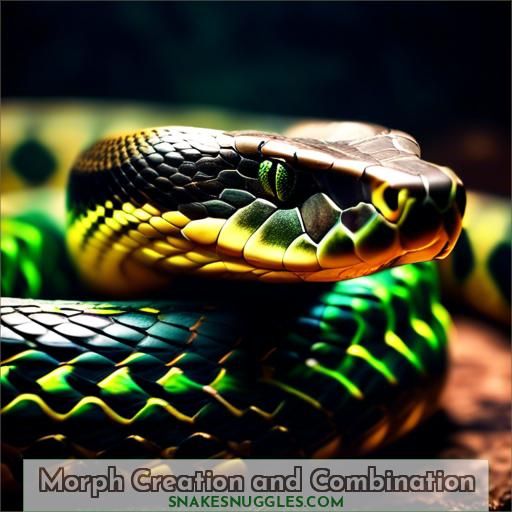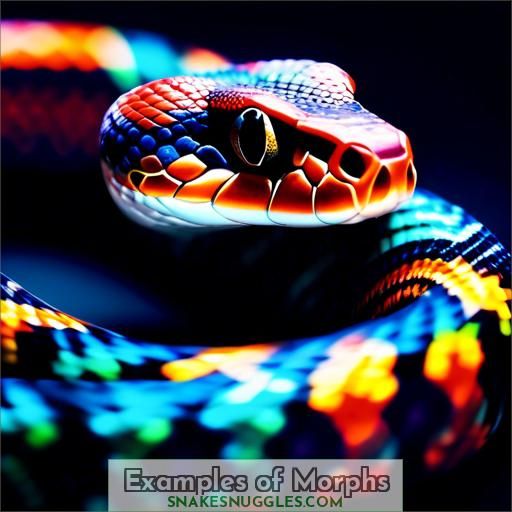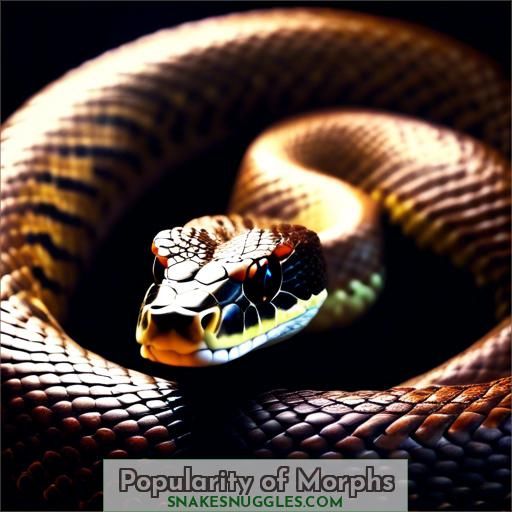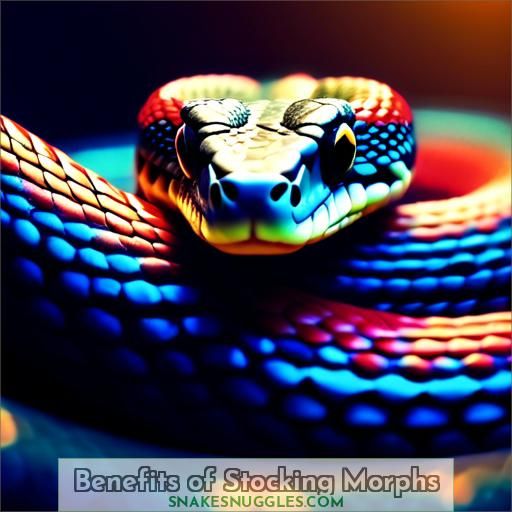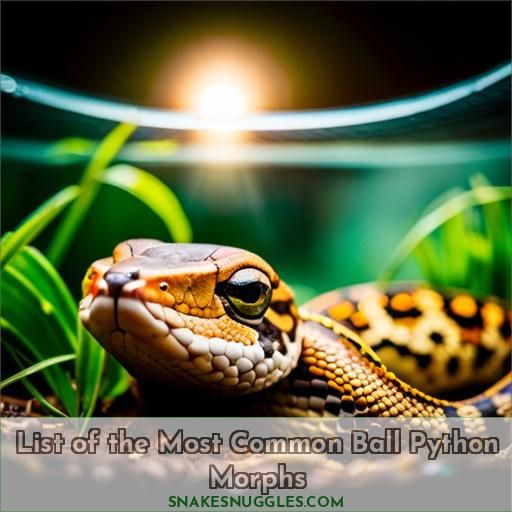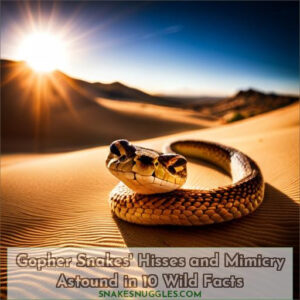This site is supported by our readers. We may earn a commission, at no cost to you, if you purchase through links.
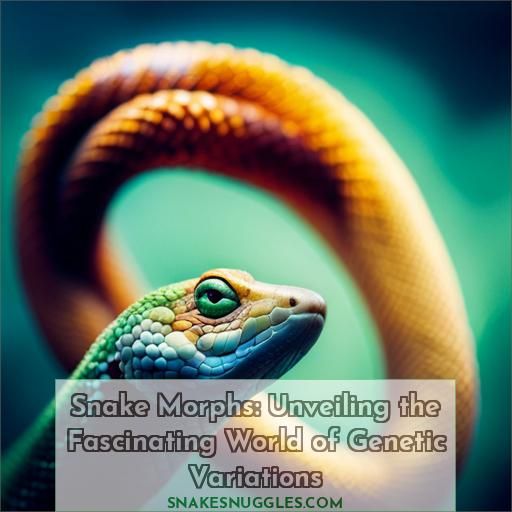
A snake morph is a genetic mutation that results in distinct physical characteristics, including color and pattern alterations. These morphs can occur naturally or through intentional breeding programs and can affect a snake’s health, behavior, or appearance. Common morph species include ball pythons, corn snakes, boa constrictors, leopard geckos, and bearded dragons.
Morphs are created through chance mutations or intentional breeding, and crossbreeding different morphs can produce animals with multiple traits. Examples of morphs include the wildtype ball python with normal coloring, the piebald morph with reduced pattern, and the albino corn snake with white or cream-colored skin.
Morphs are popular with hobbyists and reptile enthusiasts, and their popularity can impact the prices and availability of specific morphs.
Table Of Contents
- Key Takeaways
- What is a Snake Morph?
- What Are Morphs?
- Common Morph Species
- Morph Creation and Combination
- Examples of Morphs
- Controversies and Considerations
- Popularity of Morphs
- Benefits of Stocking Morphs
- List of the Most Common Ball Python Morphs
- Albino (Amelanistic)
- Caramel (Tyrosinase Positive) Albino
- Piebald
- Axanthic
- Pastel
- Spider
- Champagne
- Cinnamon
- Fire
- Mojave
- Ghost
- Yellow Belly
- Lesser Platinum / Butter
- Pinstripe
- Clown
- Scaleless
- Banana / Coral Glow
- Black Pastel
- Enchi Ball Python
- Acid Ball Python
- GHI Ball Python
- Dreamsicle Ball Python
- Sunset
- Monsoon
- Paradox Ball Pythons
- Frequently Asked Questions (FAQs)
- Conclusion
Key Takeaways
- Snake morphs are genetic mutations that result in distinct physical characteristics, including color and pattern alterations.
- They can occur naturally or through intentional breeding programs and can affect a snake’s health, behavior, or appearance.
- Common morph species include ball pythons, corn snakes, boa constrictors, leopard geckos, and bearded dragons.
- Morphs are popular with hobbyists and reptile enthusiasts, and their popularity can impact the prices and availability of specific morphs.
What is a Snake Morph?
A snake morph is a genetic mutation that alters a reptile’s appearance, including its color and pattern. These mutations can be inherited by a snake’s offspring, leading to a wide range of unique physical traits within the same species.
What Are Morphs?
You’re intrigued by the captivating world of snake morphs – genetic mutations that produce distinct physical traits. These mutations can emerge naturally or through intentional breeding programs, allowing reptile enthusiasts to uncover and propagate unique patterns, colors, and other fascinating characteristics.
Genetic Mutations That Result in Distinct Physical Characteristics in Snakes and Other Reptiles
Morphs are the genetic mutations that give snakes and other reptiles their distinct physical characteristics.
These mutations can occur naturally or be intentionally bred for, resulting in a wide variety of color and pattern alterations.
Some morphs can have health implications, while others may affect behavior or physique.
Ball python morphs, such as albino, spider, and piebald, are popular among hobbyists and can command high prices.
Understanding morph selection and intentional breeding is essential for both hobbyists and professionals in the reptile world.
Can Occur Naturally or Be Intentionally Bred For
As you embark on the exploration of snake morphs, remember that these mesmerizing variations aren’t merely the result of nature’s whims.
Breeders engage in a strategic game with genetics, meticulously pairing ball pythons to manifest the most striking patterns.
However, it’s not all about visual appeal; ethical breeding places utmost importance on genetic preservation, ensuring that each allele contributes to a robust lineage without jeopardizing their natural environment.
Common Morph Species
Morphs are genetic mutations that result in distinct physical characteristics in snakes and other reptiles. They can occur naturally or be intentionally bred for. Common morph species include Ball Pythons, Corn Snakes, Boa Constrictors, Leopard Geckos, and Bearded Dragons.
Morphs are created through chance mutations or intentional breeding. Crossbreeding different morphs can produce animals with multiple traits. Examples of morphs include the wildtype Ball Python with normal coloring, the piebald morph with a reduced pattern, and the albino Corn Snake.
Controversies and considerations surrounding morphs include their potential effects on behavior and health, as well as concerns about inbreeding due to limited genetic diversity.
Morph Creation and Combination
You have two main options for creating snake morphs: chance mutations or intentional breeding. By crossbreeding different existing morphs, you can produce offspring with combined traits, stacking multiple unusual physical characteristics into a single snake.
Chance Mutations or Intentional Breeding
Morphs in snakes and other reptiles are the result of genetic mutations that create unique physical characteristics. These mutations can occur naturally or be intentionally bred for. Here are five ways genetic variation is used in the creation and combination of morphs:
- Selective breeding: Breeders choose parents with desired traits to create offspring with those traits.
- Conservation genetics: Breeding programs help protect endangered species by preserving their genetic diversity.
- Genetic drift: Random events can lead to changes in gene frequencies within a population.
- Gene flow: The exchange of genetic material between populations can introduce new traits.
- Pinstripe, cinnamon, fire, scaleless, acid ball python: These are examples of morphs created through intentional breeding.
Crossbreeding Different Morphs Can Produce Animals With Multiple Traits
Crossbreeding diverse morphs can yield creatures with multifaceted attributes.
This stems from genetic combinations, which may result in distinctive color patterns and other physical traits.
Selective breeding exerts a profound influence on this process, as breeders endeavor to produce offspring with sought-after genetic attributes.
Morph evolution is an ongoing endeavor, with novel morphs being unveiled and cultivated through deliberate breeding.
However, it’s imperative to take into account the health repercussions of these genetic combinations, as certain morphs can impact behavior and health.
Examples of Morphs
You’re familiar with the classic wildtype ball python’s sleek black and brown body adorned with alien-like patterns. But have you witnessed the striking piebald morph’s reduced patterning, resulting in patches of smooth, unmarked scales? This genetic mutation produces a captivating contrast between patterned and non-patterned areas, displaying the incredible diversity of ball python morphs.
Wildtype Ball Python: Normal Coloring
Leaving the realm of transformative creations, let’s not forget the allure of the pristine Wildtype ball python. In its unadorned form, this prevalent species exhibits:
- An intricate pattern echoing the enigmatic symbols of antiquity.
- The elegance of simplicity in its customary coloration.
- An enduring testament to the inherent beauty that captivates both seasoned and fledgling reptile aficionados.
Piebald Morph: Reduced Pattern
The Piebald Morph, also known as the Clown Morph, is a genetic mutation that results in a reduced pattern on a snake’s body.
It’s a recessive allele, meaning both parents must carry the gene for it to manifest in their offspring.
This morph can be found in various species, including King Snakes and Boa Constrictors.
Selective breeding has led to the creation of other color variations, such as the Banana/Coral Glow Morph, which is a combination of the Piebald and Albino genes.
Controversies and Considerations
While morphs can produce visually stunning animals, you must carefully consider the potential health and behavioral implications. Inbreeding to establish desired traits raises concerns about limited genetic diversity, which could negatively impact the animal’s wellbeing.
Some Morphs Can Affect Behavior and Health
Delving deeper into the realm of morph breeding, it’s imperative to acknowledge that appearances can be deceptive.
While the charm of a scaleless variation or the captivating looks of a lesser platinum/butter may entice, these genetic alterations can sometimes jeopardize morph well-being.
The spider morph and jaguar gene, for example, have been associated with significant behavioral implications, emphasizing the need to prioritize genetic diversity.
Others Alter Physique
Morphs not merely have behavioral and health implications, but they also transform the physicality of the reptiles they impact.
Certain morphs, such as the albino mutation, can induce remarkable visual distinctions in species like corn snakes and leopard geckos.
These transformations can bear ethical ramifications for breeders and preservationists, as well as health implications for the creatures themselves.
It’s imperative to ponder these elements when breeding and introducing novel morphs into the market.
Inbreeding is a Concern Due to Limited Genetic Diversity
Inbreeding poses concerns due to restricted genetic diversity.
Morphs may entail genetic implications, such as elevated risks of deformities and health complications.
Breeding practices necessitate meticulous consideration to avert these issues.
Conservation concerns emerge when uncommon morphs are bred, potentially affecting wild populations.
For instance, Burmese pythons and reticulated pythons have confronted challenges with inbreeding.
It’s imperative to strike a balance between the pursuit of distinctive morphs and the necessity for genetic diversity.
Popularity of Morphs
You’ve likely noticed the rising popularity of snake morphs, particularly with leopard geckos and ball pythons. Ball python morphs have especially gained significant attention and premium prices in recent years due to their striking colors and patterns. With hobbyists seeking rare and unique reptiles, stocking popular morphs can attract a dedicated clientele to your store.
Leopard Gecko and Ball Python Morphs Sell Well
Leopard gecko and ball python morphs are highly coveted in the reptile community.
They are characterized by their distinctive characteristics and aesthetic allure.
These morphs may arise from fortuitous genetic variations or strategic breeding practices.
Their desirability has engendered heightened demand and market value.
However, it’s imperative to contemplate the potential ramifications for behavior, well-being, and genetic diversity when engaging with these morphs.
Notable examples include the Sunset, Champagne, and Paradox ball pythons.
They are renowned for their vivid hues and intricate patterns.
Ball Python Morphs Have Gained Attention and High Prices
Ball python morphs have gained attention and high prices due to their unique genetic traits. Breeders cross morphs to create new and desirable offspring, leading to a variety of morphs available. However, this can also raise concerns about genetic diversity and potential health issues. Morph breeding has become a popular trend, with market demand influencing price fluctuations. Here are four key points to ponder:
- Genetic diversity: The more diverse the genetic pool, the healthier the offspring.
- Health concerns: Some morphs may have negative health effects, such as reduced fertility or increased susceptibility to disease.
- Price fluctuations: The rarity and desirability of a morph can greatly affect its price.
- Market demand: The popularity of certain morphs can drive up demand and prices.
Benefits of Stocking Morphs
Stocking morphs is an excellent way to distinguish your store from big-box retailers that only carry standard reptiles. You’ll attract passionate hobbyists who need specialized equipment and supplies, and they’ll likely make additional purchases while visiting your shop for the unique morphs.
Attract Serious Hobbyists Who Need Replacement Supplies
As a retailer, stocking morphs can allure discerning hobbyists in need of replacement supplies. With the surge in morph popularity and demand, offering a diverse selection can differentiate your store from rivals. However, morph pricing can pose a challenge. Striking a delicate balance between affordability and attracting serious hobbyists is crucial. Monitor morph trends vigilantly to guarantee your store’s competitiveness.
Set Store Apart From Superstores That Carry Standard Forms
Set Your Store Apart with Morphs
Morphs are unique genetic mutations that set your store apart from the competition. Here’s how:
- Morph Availability: Offer a wide range of morphs to cater to diverse customer preferences.
- Morph Prices: Attract serious hobbyists with high-quality, rare morphs at competitive prices.
- Morph Care: Educate customers on morph-specific care needs to guarantee their reptiles thrive.
- Morph Legality: Stay updated on morph regulations to confirm you’re selling lawful morphs.
Get Reptile Enthusiasts Through Doors, Where They Might Buy Something Else
By stocking morphs, you can attract reptile enthusiasts through your doors, where they might buy something else.
Morph availability varies by species, with some having dozens or even hundreds of morphs.
This diversity can boost profit margins and make your store stand out from superstores that carry standard forms.
Don’t forget to educate customers about ethical breeding practices, ensuring they’re making informed decisions.
Variety of Morphs Becoming More Affordable
Embarking on the journey of morphs, you’ll discover that the formerly exorbitant prices have become more affordable.
This change isn’t merely about financial savings; it’s a testament to innovative breeding techniques that have increased genetic variety while mitigating health risks.
Each morph, with its distinct physical transformations, captivates the senses and enhances its market value, making exceptional beauty available to all.
Morphs Becoming More Popular
As genetic diversity expands, the allure of morphs intensifies.
These distinct color variations emerge from serendipity or deliberate breeding, gaining wider availability and affordability.
Morphs may exert varying effects on health, emphasizing the importance of comprehending your reptile’s genetic heritage.
By showcasing a diverse array of morphs, you can captivate dedicated enthusiasts and differentiate your establishment from rivals.
The escalating popularity of morphs represents a golden opportunity for retailers, providing a variegated product line that resonates with a broader clientele.
List of the Most Common Ball Python Morphs
Ball pythons showcase an incredible array of genetic morphs, each with its own distinct appearance.
From the striking albino and caramel varieties to the visually arresting piebald, axanthic, and pastel morphs, the sheer diversity within this species is truly remarkable.
While favorites like the spider, champagne, and cinnamon morphs have long captivated reptile enthusiasts, innovative breeders continue to introduce novel combinations.
Such as the fire, mojave, ghost, and yellow belly morphs, further expanding the boundaries of what’s possible.
Albino (Amelanistic)
Albino (Amelanistic) Ball Python Morph: A Striking Genetic Variation
The albino (amelanistic) ball python morph is a remarkable genetic variation that presents with a distinct set of characteristics. This morph is distinguished by its absence of melanin, leading to a light, white, or cream-colored appearance. Here are some critical points to bear in mind:
- Albino genetics: The albino trait is a recessive gene, meaning both parents must possess the gene for their offspring to exhibit the albino morph.
- Morph development: Albino ball pythons may showcase reduced patterns and a paler overall appearance compared to their natural counterparts.
- Color variations: While albino ball pythons are typically white or cream, they may also exhibit subtle color variations, such as pink or orange hues.
- Genetic inheritance: The albino gene is inherited in a straightforward Mendelian manner, with a 25% probability of an offspring inheriting the gene from both parents.
- Health considerations: Albino ball pythons may be more susceptible to certain health issues, such as increased sensitivity to light and potential vision impairments, due to their lack of pigmentation.
As a conscientious breeder or enthusiast, it’s imperative to comprehend the potential implications of the albino gene on the health and well-being of these reptiles.
Caramel (Tyrosinase Positive) Albino
Caramel Albino, also known as Tyrosinase Positive Albino, is a unique morph in the ball python species.
This morph is characterized by its caramel-colored skin, which results from a mutation in the tyrosinase gene.
Unlike traditional albinos, these snakes have a brownish base color with pinkish-red eye color, making them distinct from other morphs.
They are highly sought after by collectors and breeders due to their unique appearance.
Piebald
Embark upon the realm of piebald heredity, where the whims of genetic destiny weave an enchanting tapestry of unpigmented patches upon a vibrant canvas. Piebald propagation presents an intriguing game of chance:
- Every offspring, an exclusive work of art.
- Piebald hues, a capricious kaleidoscope.
- Well-being and conduct, predominantly unaffected.
- A breeder’s aspiration, each union bestowing an unforeseen unveiling of nature’s artistry.
Axanthic
Axanthic genetics involve a recessive mutation that affects the production of pigments in a snake’s skin, leading to a unique coloration.
Axanthic snakes often have a translucent or transparent appearance, with the underlying colors and patterns being more visible.
This morph can affect health, as the reduced pigmentation can make the snake more susceptible to sunburn and UV damage.
Axanthic breeding and crossbreeding can produce animals with multiple traits, creating a diverse range of morphs.
Pastel
Exploring the enchanting world of ball python morphs, we now venture into the captivating realm of the pastel morph. This mesmerizing morph displays a unique blend of colors, creating a breathtaking visual spectacle. Here are four key points to ponder when it comes to pastel morph characteristics, breeding techniques, health considerations, and accessibility:
- Essential Characteristics: Pastel morphs exhibit a delicate, muted color palette, often featuring a fusion of creamy hues and subtle shading.
- Breeding Techniques: Breeding pastel morphs requires meticulous selection of parents with desirable traits, ensuring a successful breeding process.
- Health Considerations: Like any morph, pastels may encounter health issues related to inbreeding and genetic diversity. Regular care and monitoring are paramount.
- Accessibility and Price Trends: Pastel morphs have gained popularity, leading to increased accessibility and escalating prices, making them a coveted addition to any reptile enthusiast’s collection.
Spider
The Spider morph is a striking genetic variation in Ball Pythons, distinguished by an unusual pattern of spots reminiscent of spider appendages.
This morph arises from a recessive gene, indicating that both progenitors must possess the gene for the progeny to display the spider pattern.
The Spider morph is admired by reptile aficionados for its distinctive appearance.
However, it’s imperative to contemplate the potential health ramifications of inbreeding, as the diminished genetic diversity can result in complications.
Breeders must exercise caution when breeding Spider morphs to ensure a robust and diverse population.
Champagne
The Champagne morph, also known as the Champagne Ball Python, is a fascinating genetic mutation in the ball python species. Here are four key points to understand about this unique morph:
- Champagne genetics: The Champagne morph is characterized by a light, champagne color with black or dark brown blotches. This coloration is due to a recessive gene that alters the pigmentation of the snake’s scales.
- Champagne breeding: Breeding Champagne morphs involves careful selection of parents with the desired traits. The offspring inherit the champagne coloration from both parents, making it a homozygous trait.
- Champagne care: Champagne Ball Pythons require the same care as other ball pythons, including a proper diet, humidity, and temperature. However, their lighter coloration may make them more susceptible to sunburn, so they should be kept in shaded areas.
- Champagne popularity: The Champagne morph is highly sought after by reptile enthusiasts due to its unique coloration and rarity. As a result, it can command high prices in the market.
Cinnamon
The Cinnamon morph is a striking pattern variation in Ball Pythons. It’s an inherited characteristic that results in a reddish-brown coloration, giving the snake an inviting, earthy appearance. Breeders frequently combine this morph with others to create one-of-a-kind offspring. However, it’s crucial to reflect on responsible breeding practices and the potential impact on genetic variety.
Fire
Imagine your ball python igniting the terrarium with its fiery presence. That’s the allure of the fire morph, a genetic marvel that’s not just a hot commodity but also widely available. Caring for these radiant beauties is straightforward, and breeding them can fan the flames of genetic diversity. Rest assured, indulging in the fire morph’s glow is perfectly legal.
Mojave
Mojave Ball Python: An Enchanting Morph with Distinct Genetics
Mojave Ball Pythons are an alluring variant of the common ball python, renowned for their striking appearance and particular genetic makeup. First bred in 2000, the Mojave Ball Python is a relatively recent morph that has become a cornerstone in any ball python breeder’s repertoire. This morph represents a co-dominant mutation, signifying that it can produce both Mojave and Standard ball pythons when crossbred with other color variants.
The Mojave Ball Python’s pattern is distinguished by large, circular patches adorned with diminutive, dark brown dots at their centers, generating a high-contrast appearance. The precise coloration may vary, but they’re typically snakes with high contrast, featuring an abundance of golden, gray, and dark brown hues. This morph is readily identifiable by its intense flamboyant patterning and the keyhole design of its enigmatic alien heads, which often exhibit a solitary black dot within what resembles a keyhole.
When bred with alternative color variants, the Mojave Ball Python can give rise to exceptional morphs, such as the Blue-Eyed Leucistic Ball Python. This morph is widely favored among reptile enthusiasts due to its unique appearance and the potential to create novel and captivating morphs through breeding.
Mojave Ball Pythons are an ideal choice as a first-time pet, as they’re non-venomous, non-aggressive, and relatively easy to obtain. They’re a delight to raise and care for, making them a valuable genetic tool for creating aesthetically pleasing morphs. However, as with any morph, it’s crucial to procure your pet from a reputable breeder to safeguard the health and well-being of your new companion.
Ghost
The Ghost morph is a striking genetic mutation in ball pythons. Here’s what you need to know:
- Genetics: Ghost morph results from a recessive gene that causes the snake’s skin to appear translucent, revealing the underlying muscle structure.
- Behavior: Ghost morphs are generally docile and easy to handle, making them popular among hobbyists.
- Lifespan: Like other ball pythons, Ghost morphs can live up to 30 years with proper care.
- Breeding: Ghost morphs can be bred with other morphs to produce unique offspring, such as Ghost Pastel or Ghost Enchi.
- Availability: Ghost morphs are relatively rare and can be more expensive than other ball python morphs.
Yellow Belly
Yellow Belly is an impressive Ball Python morph with bold yellow coloration on its belly.
This morph is derived from a recessive gene and is a favored choice among enthusiasts.
To maintain optimal care, it’s crucial to comprehend the genetic basis of this morph and its potential ramifications for the snake’s well-being and behavior.
As with all morphs, judicious breeding and selection can aid in preserving the coveted characteristics while mitigating any adverse effects.
Lesser Platinum / Butter
The Lesser Platinum, also known as Butter, is a morph that enhances color and intensifies blushing in ball pythons. It’s an incomplete dominant mutation, meaning it isn’t fully displayed in the offspring of a Lesser Platinum and a normal ball python. The Lesser Platinum is part of the Blue Eyed Leucistic complex, which includes morphs like Butter, Mojave, and Phantom. This morph has been bred with various other morphs to create unique combinations, such as the Lemon Blast Ball Python, which is a cross between the Pastel and Pinstripe morphs.
When breeding Lesser Platinum ball pythons, it’s essential to weigh the genetic influence of the morph and its potential impact on the offspring. Breeders often strive for a specific number of locks per female to facilitate a successful breeding season, which can vary depending on the breeding strategy and the specific morphs involved. It’s also crucial to contemplate the ethical considerations of breeding and the market trends for different morphs, as some may be more sought-after and valuable than others.
Pinstripe
Just like the buttery smoothness of the Lesser Platinum, the Pinstripe morph slithers into the spotlight with its own brand of elegance.
Pinstripe breeding is a canvas for creativity, with genetics that paint a dominant stroke in the ball python world.
Their popularity isn’t just a pattern; it’s a confirmation of their robust care and commendable health, making them a mainstay in herpetoculture.
Clown
Clown ball pythons are a unique and sought-after morph in the reptile world. The Clown gene is recessive, meaning both parents must carry the gene for it to be expressed in the offspring. The Clown morph is characterized by a bright, gold color with burnt orange outlining and a brown back, with heads displaying aberrant patterns similar to spiders but brighter and more colorful.
Breeding Clown ball pythons can be an expensive endeavor, as it requires crossing two Clowns to produce offspring that are heterozygous for the Clown gene. This means that the offspring will carry one copy of the Clown gene from each parent, but the Clown pattern may not be visible in all of the offspring. However, when two heterozygous Clowns mate, 50% of the offspring will be heterozygous for the Clown gene, 50% will be normal, and 25% will be homozygous for the Clown gene, displaying the Clown pattern.
The Clown gene isn’t dominant, so it can be bred with other morphs to create new patterns or colors. However, if a Clown morph has any spider blood in its lineage, there’s a risk that it may suffer from head wobble or kinking, as all spiders are prone to these conditions.
In terms of care, Clown ball pythons require similar care to other Python regius morphs. They’re medium-sized pythons from Sub-Saharan Africa and are primarily exported from Benina, Ghana, and Togo. In the wild, they thrive on a diet of small rodents, amphibians, and even birds.
Scaleless
Scaleless Ball Pythons: A Journey into Exceptional Genetics and Nurturing
Breeding scaleless morphs is an enthralling voyage into the realm of serpentine genetics. These serpents, distinguished by their absence of scales, are an intriguing anomaly. While their care and conduct may diverge from their scaled counterparts, they provide an unparalleled glimpse into the diversity of reptiles.
Scaleless genetics are intricate, with diverse mutations resulting in the lack of scales. Comprehending these genetics is paramount for breeders, enabling them to craft novel morphs and uphold thriving populations.
Nurturing scaleless serpents is a delicate endeavor. Their skin is more vulnerable, necessitating a specialized diet and environment to safeguard their well-being. Behaviorally, these serpents may manifest distinct attributes, such as heightened activity or modified feeding patterns.
Banana / Coral Glow
Banana and Coral Glow are two sought-after Ball Python mutations that enhance the reptile world with vibrant hues.
These mutations arise from genetic variations or selective breeding, and their distinct characteristics may influence behavior, well-being, and reproductive capacity.
While their visual appeal is undeniable, it’s imperative to weigh the ethical ramifications of propagating and marketing these mutations.
Inbreeding poses a risk of diminished genetic diversity and potential health complications.
Black Pastel
Dive into the world of black pastel morphs, where the allure of shadowy hues meets the thrill of genetics.
Breeding these beauties can be like striking gold, or occasionally hitting a genetic snag with health quirks.
But fear not, the black pastel’s price won’t send you to the poor house, making it a dark horse worth betting on in the serpent’s kaleidoscope.
Enchi Ball Python
The Enchi Ball Python is a color and pattern altering morph that subtly increases the orange coloration and bright side patterns. It was first discovered in Ghana, Africa, and was first captive bred in 2002 by Sweball.
The Enchi morph is an incomplete dominant gene, meaning it only requires one gene from either the mother or the father to display visually. As the snake ages, it becomes more vibrant, with colors ranging from warm orange to bright yellow.
Enchi Ball Pythons have a high amount of blushing, particularly around their head, which is accented by bright yellow or golden eye stripes. The Enchi morph tends to have a reduced pattern, with alien heads becoming flat and featureless.
The Enchi Ball Python is a popular morph and is available in both standard and super forms, with the super form having a more intense yellow coloration and reduced patterning.
Acid Ball Python
The acid ball python is a unique morph resulting from selective breeding practices. This genetic variation features a bright yellow base color with a neon green pattern, creating a visually striking appearance. The acid morph showcases the potential of breeding to expand the physical characteristics of the ball python species, contributing to its overall genetic diversity.
GHI Ball Python
The GHI Ball Python, a unique reptile morph, is a fascinating creature that has gained popularity among reptile enthusiasts. This morph is characterized by its striking genetic traits and patterns, making it a desirable addition to any collection. Here are three key aspects of the GHI Ball Python:
- Genetics: The GHI Ball Python is a result of intentional breeding, where two specific morphs are crossed to produce offspring with the desired genetic traits.
- Breeding: Breeders carefully select parents with the desired traits to create the GHI Ball Python morph. The breeding process is precise and requires a deep understanding of reptile genetics.
- Patterns: The GHI Ball Python exhibits distinct patterns that set it apart from other morphs. These patterns can range from subtle to bold, adding to the morph’s overall appeal.
Dreamsicle Ball Python
The Dreamsicle Ball Python is an enchanting morph with a distinctive coloration. Bred from a combination of the Albino and Pastel morphs, it exhibits a creamy yellow base adorned with orange and black stripes. This morph is highly sought after by reptile aficionados and can be encountered in numerous breeding initiatives.
Accessibility may fluctuate, but it’s widely regarded as a coveted morph. Dreamsicle Ball Pythons necessitate meticulous care, encompassing a well-balanced diet and suitable enclosure conditions.
Sunset
Embark into the domain of the Sunset gene, a captivating entity within the realm of extraordinary genetic alterations. This gem, akin to the albino variant, exemplifies the transformative potential of selective breeding.
Beyond its aesthetic allure, it serves as a beacon of genetic diversity. Visualize the ethereal glow of a sunset encapsulated within scales, a testament to the artistry of breeding.
Monsoon
Monsoon morphs are an enchanting enhancement to the realm of ball pythons. These genetic marvels showcase an extraordinary fusion of hues and designs, rendering them highly sought-after by reptile aficionados. Here are four paramount considerations regarding monsoon morphs:
- Monsoon Ancestry: These morphs stem from meticulous breeding, interlacing distinct genetic attributes to forge novel and unparalleled patterns.
- Monsoon Procreation: Propagating monsoon morphs necessitates prudent selection and oversight to preserve desired traits and avert consanguinity.
- Monsoon Husbandry: Tending to monsoon morphs parallels the care for other ball pythons; however, it’s imperative to comprehend the distinctive requirements of these exceptional individuals.
- Monsoon Well-being: Analogous to all reptiles, monsoon morphs demand adequate nutrition, thermoregulation, and sanitation to flourish. Periodic veterinary examinations are also indispensable for their health.
Paradox Ball Pythons
The Paradox Ball Python: Genetics, Breeding, and Health
The Enigma Paradox Ball Python is an intriguing morph exhibiting a remarkable blend of colors and patterns. This enigmatic serpent emerges from a rare genetic anomaly, resulting in its captivating appearance. Let’s embark on a journey into the realm of Paradox Ball Pythons, delving into their genetics, breeding, inheritance, and health considerations.
Genetics
The Paradox mutation is intricate, involving the interplay of multiple genes. This orchestration manifests in a serpent with a striking convergence of colors and patterns, transforming each Paradox Ball Python into an exceptional masterpiece.
Breeding
Nurturing Paradox Ball Pythons requires meticulous selection of parents carrying the desired mutations. The breeding process is a delicate interplay of genetics, meticulously striving to produce offspring that inherit the Paradox traits.
Inheritance
The inheritance of Paradox mutations adheres to genetic principles, granting each offspring a probability of inheriting the coveted characteristics. Deciphering these patterns is fundamental for breeders seeking to cultivate the next generation of Paradox Ball Pythons.
Health
As with any morph, Paradox Ball Pythons can encounter health concerns. It’s paramount for breeders to adhere to responsible breeding practices, thereby mitigating the potential for health issues.
Join us as we explore the fascinating realm of Paradox Ball Pythons, unraveling their genetics, breeding, inheritance, and health considerations.
| Genetics | Breeding | Inheritance | Health |
|---|---|---|---|
| Complex mutation involving multiple genes | Meticulous parent selection | Genetic principles | Potential health concerns |
| Striking convergence of colors and patterns | Delicate genetic orchestration | Pattern comprehension | Responsible breeding |
| Exceptional masterpiece | Offspring with desired traits | Fundamental for breeders | Health issue mitigation |
Frequently Asked Questions (FAQs)
How do morphs affect snake behavior?
Morphs, those dazzling genetic twists, don’t typically sway a snake’s behavior. Whether you’ve got a flashy Albino or a classic Wildtype, their personality’s more about individual quirks than their stunning scales.
Can inbreeding lead to health issues?
Inbreeding can lead to health issues in snakes. It increases the risk of passing on deleterious genes and can isolate bad genes, increasing their frequency in the population. This can result in a higher susceptibility to a wide variety of health issues that can affect every system in the body.
To minimize these risks, breeders should avoid inbreeding as much as possible. They should introduce unrelated pairs to maintain genetic diversity.
How do morphs impact snake physique?
Morphs are genetic mutations that result in distinct physical characteristics in snakes and other reptiles. They can affect behavior and health, and inbreeding is a concern due to limited genetic diversity. Some morphs alter physique, while others may not.
What is the process of creating new morphs?
Creating new morphs in snakes is a process that involves chance discoveries of genetic mutations and intentional breeding. Morphs are discovered when a specimen** is found in the wild with a unique color or pattern mutation. If it’s determined that the difference is caused by a genetic factor, the snake can be bred and reproduced.
Intentional breeding involves crossbreeding different morphs to produce animals with multiple traits. For example, a snake with a reduced pattern and another that misses all black color can be crossbred to produce offspring that are both missing black and having a reduced pattern.
Designer morphs, which are the combination of two or more mutations in a single snake, are a result of captive breeding and aren’t likely to occur in the wild.
How do morphs impact snake reproduction?
Morphs in snakes are genetic mutations that result in distinct physical characteristics, such as color or pattern variations. They can occur naturally or be intentionally bred for. Common morph species include Ball Pythons, Corn Snakes, Boa Constrictors, Leopard Geckos, and Bearded Dragons.
Creating and combining morphs involves chance mutations or intentional breeding, with crossbreeding different morphs producing animals with multiple traits. Examples of morphs include the Wildtype Ball Python, Piebald morph, and designer morphs like the Striped Snow.
Morphs can impact snake reproduction by affecting the genetic makeup of offspring, with some morphs potentially affecting behavior and health. The popularity of morphs has led to a thriving market, with Leopard Gecko and Ball Python morphs being particularly sought after.
Breeders create new morphs through selective breeding, and the variety of morphs available varies depending on the species. While some morphs have no apparent effect on the reptile’s health or behavior, others can result in developmental abnormalities or other health issues.
The pursuit of rare or unusual morphs has led to overbreeding and increased demand for wild-caught specimens, which can have detrimental effects on reptile populations in their natural habitats. Understanding the genetic basis of morphs can have broader implications for evolutionary biology and conservation efforts.
Conclusion
Embark on the captivating odyssey of snake morphs – genetic anomalies that bestow exceptional physical attributes upon serpents. Through meticulous breeding initiatives or serendipitous mutations, these characteristics can shape a snake’s well-being, demeanor, or aesthetics.
Notable morphs encompass ball pythons, corn snakes, and leopard geckos. Their allure among aficionados and enthusiasts has a profound impact on their accessibility and market value.
Delve into the dynamic tapestry of morphs and decipher the enigmas behind their inception and intermingling.

